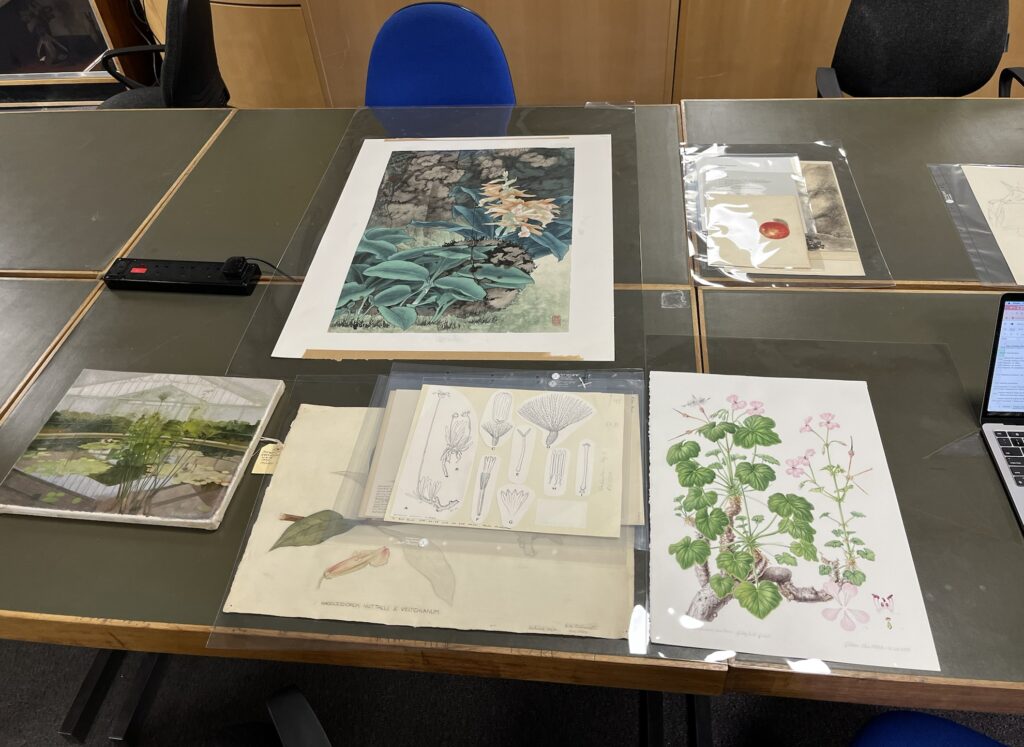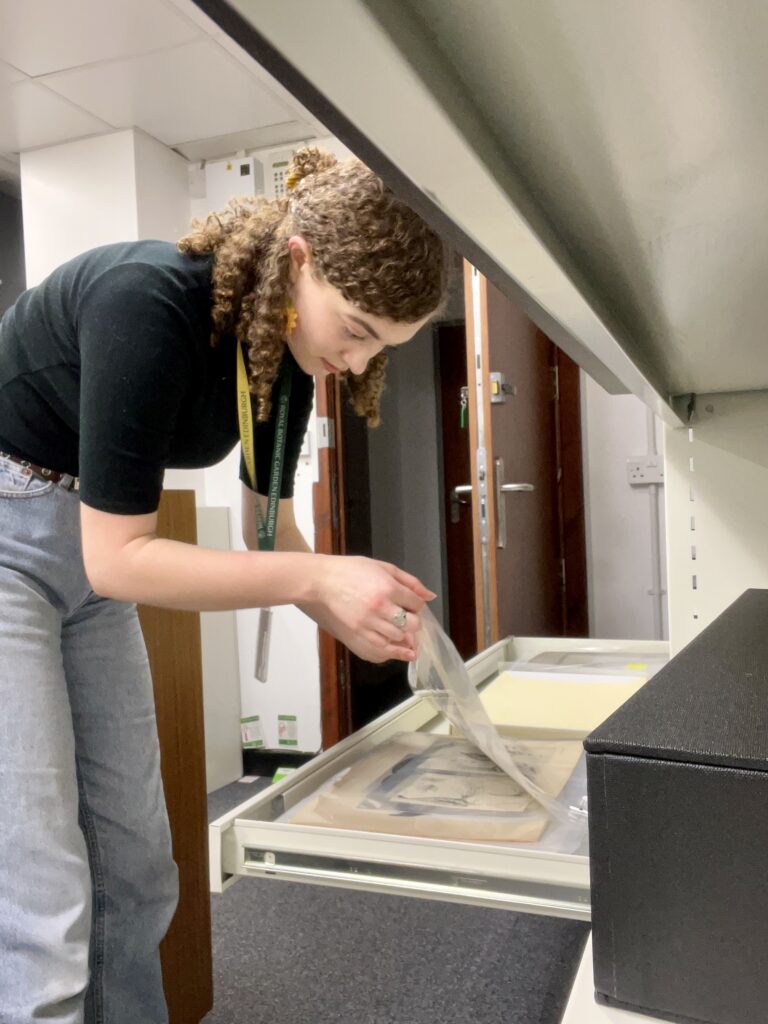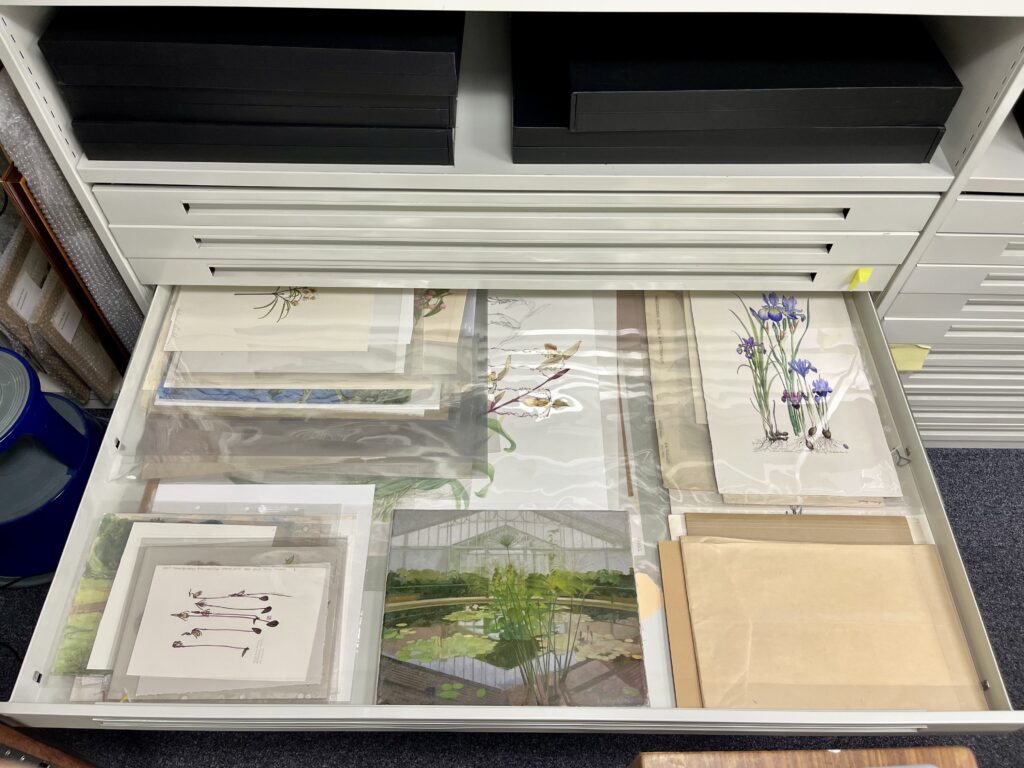By Madeleine E. Dugan
My name is Madeleine Dugan and I am an Art History Mlitt student. As part of my studies at the University of Glasgow, I participated in a work placement in the Library at the Royal Botanic Garden Edinburgh.
The RBGE Library is home to at least 20,000 original artworks, as well as prints, photographic material, and sculptural works; however, a large portion of these holdings have yet to be catalogued. Libraries and Special Collections often receive gifts of art on a monthly or even weekly basis, bringing in a constant supply of new work to bolster institutional holdings. These objects must have catalogue records in order to ensure that the Library knows where the works are stored, as well as to make sure that these pieces are available to the general public for study. This project began by undertaking a review of the most recent entries into the RBGE art collection, which came as individual or small groupings of works, rather than large collections.

The artworks were stored in the Library’s Rare Book Room within four cabinets. Represented among these works were an amalgamation of botanic watercolours and drawings, scientific illustrations for publication, mezzotints, and even an oil painting, all from a wide range of time periods and countries. While a majority of works are by contemporary artists, many date to the twentieth century, with some paintings dating back to the eighteenth century. With such a wide range of materials, dates, countries of origin, and purposes for each artwork, I began my review by viewing every individual object that was stored within the four cabinets. As I did this, I cross-referenced each work with the Library’s current catalogue spreadsheet, verifying and updating recorded information about the individual pieces. Some updates included finding life dates for artists, or identifying the proper mediums for various previously categorised artworks. Throughout this process, I created one hundred new entries of artworks that were not previously recorded in the catalogue.

As is often the case with older works that were held in private collections or used as functional objects, many artworks within these cabinets came into the Library in various conditions. Additionally, a large portion of the botanic illustrations in the RBGE Library collection once served as functional tools for identification, housed within herbarium files among plant specimens. These have been removed from the herbarium in order to preserve the materials and prevent any degradation that could occur due to being stored with the plant matter. Part of my review included writing brief condition reports, noting any areas where an artwork may be sensitive or in need of extra care. Sometimes artworks come into the collection already stored in their previous owner’s mats. Depending on the materials used in the picture framings and the storage complications that arise from these bulky boards, there are also instances where we recommend rehousing the artworks by removing their mats.
Once I had gone through all of the artworks, I took a look at the storage situation with the cabinets and began to organise the pieces into more cohesive groupings. As the largest portion of works among the four cabinets I reviewed were scientific illustrations used for publications, one full drawer was dedicated solely to these academic pieces. Due to the varying sizes of botanic artworks, two cabinets were dedicated to contemporary and modern paintings, drawings, and sketches. Every work on paper is housed in acid-free folders or glassine sheet protectors which keep the works in safe, stable condition, allowing for them to be gently stacked on top of each other. As it is preferable to keep artworks by the same artists together, works by the same artist are housed within one drawer, though they might be dispersed among others within the same drawer due to their varying sizes. The fourth cabinet holds a minimal number of historic paintings, as well as large-format artistic prints such as mezzotints and lithographs.

Once I completed this endeavor, I moved on to my next cataloguing project, which focused on a large collection of watercolour studies by Elizabeth Haig (English, 1871-1954). This collection is dispersed throughout nine different boxes, which hold vast selections of Haig’s sketches that she made throughout her travels in the Mediterranean. Once the cataloguing process was done, I created an authority record for Haig on Koha, in order to make her work accessible for future researchers. This process led to a separate blog post dedicated to Haig and her work, as well as a small exhibition of her work in the display case outside of the library.
This project served as a practical way to strengthen my skills in collections management through registration processes and cataloguing of individual objects. As an artist myself, I also enjoyed the opportunity to see the various styles and techniques exemplified by the assortment of artists within the RBGE holdings. Working with the historic and contemporary botanic art collection has also inspired me to re-explore my own artistic practice and take advantage of the Spring sun by sketching the blooming crocuses, daffodils, and glory-of-the-snows from life. The project has also helped to make these works more accessible, physically and digitally, for the Library collections. I am grateful for the opportunity to have worked on this collection and for Lorna Mitchell’s mentorship.
